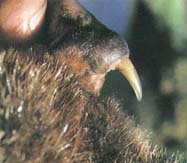
Photo courtesy of http://www.edu.pe.ca/southernkings/platypus.htm
|
|
| Home Page | 
Photo courtesy of http://www.edu.pe.ca/southernkings/platypus.htm |
| Very little experimental data
exists which documents the effects of platypus venom on humans or other
animals. Therefore, most evidence consists of dated, embellished anecdotal
accounts of old, grizzled Australian fisherman. From these stories, male
platypuses have been reported to spur both rival male platypuses and hunting
dogs to death, but have never been linked to any human fatalities. However,
in the last decade, two clinical case reports have been conducted and have
recorded the physiological effects of platypus envenomation on the human
body in a scientific manner.
In May of 1991, a 57- year-old war veteran with previous experiences of shrapnel wounds was spurred (Fig. 3) by a platypus in the mountains of North Queensland, Australia while fishing in a river. Struck on both the back of the right hand and the middle finger of the right hand, the man experienced immediate, severe pain and intense swelling in the right hand. According to the fisherman, the pain and swelling worsened with time and reached a peak intensity approximately 90 minutes after envenomation, but did not lessen thereafter. Testifying that the platypus spurring was much more excruciating than a shrapnel wound, the war veteran claimed to become incoherent as aresultof the intense pain. The fishermanís right hand and forearm was so sensitive that any slight movement or soft touch, even the light weight of a warm towel, caused increased, unbearable pain (Fenner et al., 1992). |
Figure 3: The Venomous Spur of a Platypus

Photo courtesy of http://home.mira.net/~areadman/plat.htm |
| Upon arrival to the hospital
four hours after envenomation, the pulse rate, respiration rate, and blood
flow of the fisherman were taken and proved to be normal. Also, the patient
displayed normal renal and liver activity along with normal electrolyte,
blood count, and cardiac enzyme levels. Attempts to ice the right hand
or place the right hand in warm water proved unsuccessful due to unremitting
pain. So, the patientís arm was elevated in a sling and 15 mg of morphine
was administered intravenously. However, this provided no pain relief.
Repeated 7.5 mg doses of morphine were given to the patient at 15 minutes
and 30 minutes after the initial morphine treatment. This finally reduced
pain to a tolerable level, according to the patient. However, the patient
contested that no significant pain relief occurred until a right wrist
block with 0.5% bupvicaine was established (Fenner et al., 1992).
Discharged after six days from the hospital, the patient experienced significant pain two weeks after being envenomated "to the point that he was unable to put any pressure on the hand and had trouble grasping objects" (Fenner et al., 1992). The patient still showed effects of the envenomation after three months with stiffness and swelling of the middle finger. Hand usage had improved, but was not back to normal (Fenner et al., 1992). |
 |